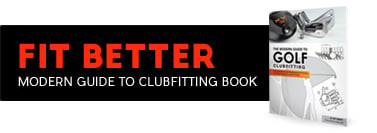How is the Lie Angle of a Golf Club Measured?
The lie of a golf club is important from a directional standpoint for any club in the golf bag. When the lie is not matched properly it can have an effect of producing a shot that either goes right or left of the intended target line even on a perfectly good swing plane and path. Lie is closely tied together with how the length of a golf club is measured and one can’t usually be mentioned without the other. But before we can address the impact of an improper lie angle first, we need to address how the lie angle of a golf club is exactly measured.
Definition of golf club lie angle
One specification that is often supplied by manufacturers is the lie of a golf club. Here is a modern day definition of lie, along with a visual diagram.
Golf Lie Angle: The angle between the shaft and the ground line when the club is measured in normal playing position with the center of the sole touching the ground line.
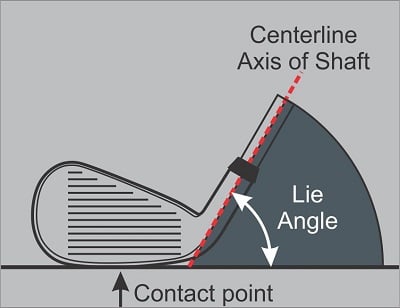 The lie is most easily measured using an industrial golf club specification gauge that the foundries, golf club manufacturers and very few golf clubmaking shops have access to. The golf clubhead is placed into the gauge and adjusted until the center of the sole touches the base of the gauge with the club in the face angle designed by the manufacturer. The angle formed from the base of the specification gauge to the shaft’s axis can be read off of the precision gauge. In our example, the result is 60 degrees. A higher number, the more vertical the golf shaft axis while a lower number would position the shaft axis closer to the ground line.
The lie is most easily measured using an industrial golf club specification gauge that the foundries, golf club manufacturers and very few golf clubmaking shops have access to. The golf clubhead is placed into the gauge and adjusted until the center of the sole touches the base of the gauge with the club in the face angle designed by the manufacturer. The angle formed from the base of the specification gauge to the shaft’s axis can be read off of the precision gauge. In our example, the result is 60 degrees. A higher number, the more vertical the golf shaft axis while a lower number would position the shaft axis closer to the ground line.
There is also loft and lie machines available that can measure the lie of the club, although they may reference the scoring lines rather than the sole. On irons, generally the score lines will be designed to be parallel to the ground line when the center of the sole touches the ground line. However, on woods, hybrids and even wedges, this may not always be the case.
The Lie “Triangle”
One way to illustrate lie is to take a club and put it on a table or workbench with the butt end of the club touching a wall. There are numerous  positions the club could be positioned, but only one will allow the center of the sole of the club to be making contact with the surface the club is resting on. This will create what I refer to as the “Triangle” where the club, wall, table’s surface form the three sides.
positions the club could be positioned, but only one will allow the center of the sole of the club to be making contact with the surface the club is resting on. This will create what I refer to as the “Triangle” where the club, wall, table’s surface form the three sides.
In this example, the golf club length is 38” measured along the back side if the shaft to the ground. Let’s say in order for the center of the sole to be touching the surface, the butt end of the grip is 32.91” off of the ground (OK, your ruler will probably read 32 7/8”). Two sides of a triangle is all you need to know to find the remaining sides and ensuing angles – who said math isn’t fun? The harder measurement is the distance from the wall to the back side of the heel as the heel will rest off of the ground due to the radius of the sole. It is usually simpler to find out its length mathematically.
For those that love math
From trigonometry, you can use the following formula to find what the lie angle is. You will need a scientific calculator.
Sin-1 (32.91”/38”) = sin-1 (0.866”) = 60°
From there we can find the length of the remaining side:
Cos (60°) X 38” = Cos (0.5) x 38” = 19.00”
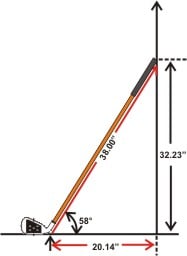 What is an upright lie angle?
What is an upright lie angle?
Take the same club and slide the butt end down the wall so the butt end is approximately 32.23” (38 ¼”) off of the surface. There will be two things that will become obvious. The first is the heel of the club is further away from the wall. By moving the butt end 5/8” lower toward the surface, it kicks out the heel approximately 1 1/8” outward to 20.14”. The second is the heel portion of the club is resting off of the ground rather than the center of the sole. This is because you changed the lie angle of the club at address. The lie angle of the club in this position is: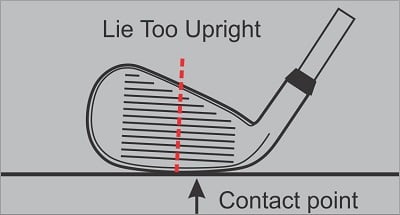
Sin-1 (32.23”/38”) = Sin-1 (0.848”) = 58°
Now, it is important to realize that this is not the lie of the head, as the lie did not change at all because it does not meet the requirements of the lie definition. The manufacturer intended for the club at impact to have the center of the sole touching the ground. Therefore when the heel of the club makes contact with the ground first or "toe up", the club is said to be too upright. Then the hosel of the club would either need bent flatter or a head selected with the corresponding flatter lie angle.
(Note: at address the club may rest on the heel, but the club may flatten out during the swing or the golfer may raise or lower their hands between the address position and impact. That is why we are only concerned with impact.)
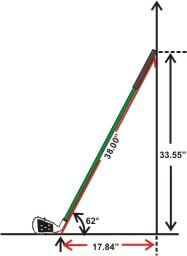
What is a flat lie angle?
Let us demonstrate the opposite by moving the heel of the club closer to the wall. Slide the butt end up the wall so the butt end is approximately 33.55” (38 1/2”). The lie angle of the club in this position is now:
Sin-1 (33.55”/38”) = Sin-1 (0.883”) = 62°
The length of the remaining side:
Cos (62°) X 38” = Cos (0.469) x 38” = 17.84”
To the right is a close up of the club in the position. Contact on the sole is made toward the toe ofthe club. Again the manufacturer intended for the club at impact to have the center of the sole touching the ground or "toe down". Therefore when the toe of the club makes contact with the ground first, the club is said to be too flat. Then the hosel of the club would either need bent upright or a head selected with the corresponding upright lie.
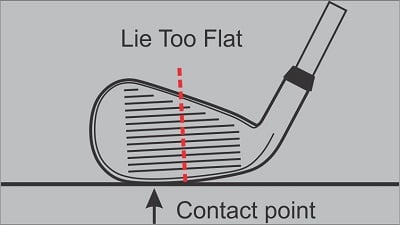 Because the golf club length of a club may be fixed, it is the lie that controls the length the club is in both the vertical and horizontal positions. Why is this important? Two degrees either direction does not sound like much, but just this little amount altered the height of the club a total of 1.32” in the vertical and 2.3” in the horizontal direction. This is why we have different length and lie combinations for golfers to not only adjust for their height, but to adjust for both the distance you stand away from the ball and your posture or where your wrists are upon impact.
Because the golf club length of a club may be fixed, it is the lie that controls the length the club is in both the vertical and horizontal positions. Why is this important? Two degrees either direction does not sound like much, but just this little amount altered the height of the club a total of 1.32” in the vertical and 2.3” in the horizontal direction. This is why we have different length and lie combinations for golfers to not only adjust for their height, but to adjust for both the distance you stand away from the ball and your posture or where your wrists are upon impact.
A few words about lie angle
When we talk about lie angle, most seasoned golfers immediately think of irons and wedges being able to be altered for lie angle. That is because many clubmaking and repair shops have an iron loft and lie machine and offer the service of bending. Even then, there are always exceptions to being able to safely alter some irons and wedges without breakage because of the clubhead material and heat treatment.
There are standalone putter machines that can also securely clamp a putter and bend them assuming of course the material is bendable. Lastly, some golf club bending machines can clamp drivers, fairway woods and hybrids. These are mainly used for measuring the loft, lie and face angle because most of the hosels on these types of clubs cannot be physically bent. However, if they are equipped with an adjustable shaft sleeve, the lie angle on these types of clubs can be changed by repositioning the adapter sleeve in a different position.
Like most specifications in golf, there are no industry standards for lie angle. For instance, one manufacturer might offer their putter with a lie angle of 71°. Another manufacturer or even another series from that same manufacturer might be 1 degree flatter (70°) or 1 degree more upright (72°) as their stated specification.

